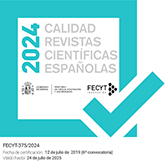The role of perception in yeísmo: A preliminary study with Catalan-speaking listeners
DOI:
https://doi.org/10.3989/loquens.2014.010Keywords:
speech perception, yeísmo, Spanish phonetics, sound changeAbstract
Yeísmo, as a change in progress in the Spanish phonological system, has been studied from various perspectives, especially from dialectology and articulatory phonetics. However, the role of the listener in its origins and spread has been scarcely analysed. In fact, it is necessary to focus on the side of the listener to detect if the articulatory similarity of sounds [ʎ] and [j] can be perceptively ambiguous and, thus, confounded. The present work wants to examine this topic in order to determine how the innovative neutralization could initiate. With this purpose we have carried out a perception study which consisted of three different tests: the first one worked as control test and the other two were used to find out if the change could be related to signal reception problems or to opacities in the input segmentation. In these experiments, we have used samples from a Spanish speaker who upholded /ʎ/ and /ʝ/ distinction (second test) and from a yeísta speaker (third test). Despite our concern is to analyse the dephonologization of /?/ in Spanish, there is an important obstacle to achieve our goal: it is quite difficult to find Spanish speakers that do preserve the phonological distinction between /ʎ/ and /ʝ/ in the same way Spanish system once did. Therefore, we must rely on compared grammar: the judges of the perception tests were 20 Catalan speakers, a language that keeps this phonological contrast. The results display that 30 % of the stimulus from Spanish speakers were misinterpreted. In addition, data suggest that the presence of an adjacent palatal vowel and the occurrence in an unstressed position may favour the confusion and, hence, the recategorization process.
Downloads
References
Alarcos Llorach, E. (1965). Fonología española (4.ª ed.). Madrid: Gredos.
Alarcos Llorach, E. (1994). Gramática de la lengua española. Madrid: Espasa-Calpe, Real Academia Española de la Lengua.
Alcina Franch, J., & Blecua, J. M. (1975). Gramática española. Barcelona: Ariel.
Blevins, J. (2004). Evolutionary Phonology. Cambridge: Cambridge University Press. http://dx.doi.org/10.1017/CBO9780511486357
Colantoni, L. (2008). Variación micro y macro fonética en español. Estudios de Fonética Experimental, XVII, 65–104.
Coloma, G. (2012). Caracterización fonética de las variedades regionales del español y propuesta de transcripción simplificada. Revista de Filología Románica, 28, 11–27. http://dx.doi.org/10.5209/rev_RFRM.2011.v28.37217
Fernández Planas, A. M. (2001). Estudio electropalatográfico de la coarticulación vocálica en estructuras VCV en castellano (tesis doctoral). Barcelona: Universitat de Barcelona. Disponible en http://www.tdx.cat/handle/10803/2094.
Fernández Trinidad, M. (2010). Variaciones fonéticas del yeísmo: Un estudio acústico en mujeres rioplatenses. Estudios de Fonética Experimental, XIX, 263–292.
Flemming, E. (2004). Contrast and perceptual distinctiveness. In B. Hayes, R. Kirchner, & D. Steriade (Eds.), Phonetically based phonology (pp. 232–276). Cambridge, UK: Cambridge University Press. http://dx.doi.org/10.1017/CBO9780511486401.008
García Mouton, P., & Molina Martos, I. (2012). The /?/ - /?/ merger (yeísmo) in Central Spain: Advances since the ALPI. Dialectologia, III, 23–42. Disponible en http://www.raco.cat/index.php/Dialectologia/index
Gómez, R., & Molina Martos, I. (Eds.). (2013). Variación yeísta en el mundo hispánico. Madrid: Iberoamericana/Vervuert.
Hernando Cuadrado, L. A. (2001). Sobre el origen y situación actual del yeísmo en Hispanoamérica. Studia Carande: Revista de Ciencias Sociales y Jurídicas, 6, 449–460.
Hualde, J. I. (2005). The sounds of Spanish. Cambridge, UK: Cambridge University Press.
Johnson, K. (2003). Acoustic and auditory phonetics (2nd ed.). Malden, MA: Blackwell.
Kochetov, A., & Colantoni, L. (2011). Coronal place contrasts in Argentine and Cuban Spanish: An electropalatographic study. Journal of the International Phonetic Association, 41(3), 313– 342. http://dx.doi.org/10.1017/S0025100311000338
Ladefoged, P., & Maddieson, I. (1996). The Sounds of the world languages. Oxford: Blackwell. PMCid:PMC178011
Lindblom, B. (1990a). Explaining phonetic variation: A sketch of the H&H Theory. In W. J. Hardcastle & A. Marchal (Eds.), Speech production and speech modelling (pp. 403–439). Dordrecht: Kluwer Academic. http://dx.doi.org/10.1007/978-94-009-2037-8_16
Lindblom, B. (1990b). Models of phonetic variation and selection. PERILUS, XI, 65–100.
Marrero Aguiar, V. (2008). La fonética perceptiva: trascendencia lingüistica de mecanismos neuropsicofisiológicos. Estudios de Fonética Experimental, XVII, 207–245.
Martínez Celdrán, E. (2004). Problems in the classification of approximants. Journal of the Acoustic Society of America, 34(2), 201–210. http://dx.doi.org/10.1017/s0025100304001732
Martínez Celdrán, E., & Fernández Planas, A. M. (2007). Manual de fonética española: Articulaciones y sonidos del español. Barcelona: Ariel.
Molina Martos, I. (2006). Innovación y difusión del cambio lingu..stico en Madrid. Revista de Filología, LXXXVI(1), 127–149. http://dx.doi.org/10.3989/rfe.2006.v86.i1.5 http://dx.doi.org/10.3989/rfe.2006.v86.i1.5
Moreno Fernández, F. (2004). Cambios vivos en el plano fónico del español: Variación dialectal y sociolingu.stica. In R. Cano Aguilar (Coord.), Historia de la lengua española (pp. 973–1010). Barcelona: Ariel.
Navarro Tomás, T. (1964). Nuevos datos sobre el yeísmo en España. Thesaurus: Boletín del Instituto Caro y Cuervo, XIX(1), 1–17.
Ohala, J. J. (1981). The listener as a source of sound change. In C. S. Masek, R. A. Hendrick, & M. F. Miller (Eds.), Papers from the parasession on language and behavior (pp. 178–203). Chicago: Chicago Linguistic Society.
Ohala, J. J. (1996). Speech perception is hearing sounds, not tongues. Journal of the Acoustic Society of America, 99(3), 1718–1725. http://dx.doi.org/10.1121/1.414696
Ohala, J. J. (2012). The listener as a source of sound change. An update. In M.-J. Solé & D. Recasens (Eds.), The initiation of sound change. Perception, production, and social factors (pp. 21–35). Amsterdam: John Benjamins. http://dx.doi.org/10.1075/cilt.323.05oha
Quesada Pacheco, M. Á. (Ed.) (2010). El español hablado en América Central. Nivel fonético. Madrid: Iberoamericana/Vervuert.
Quilis, A. (1999). Tratado de fonología y fonética españolas (2.a ed.). Madrid: Gredos.
Quilis, A., Esgueva, M., Gutiérrez Araus, M. L., & Cantarero, M. (1979). Características acústicas de las consonantes laterales españolas. Lingu..stica Española Actual, 1, 233–343.
Real Academia Española. (2011). Nueva gramática de la lengua española. Fonética y fonología. Madrid: Espasa-Calpe.
Recasens, D. (1991). Fonetica descriptiva del català: assaig de caracterització de la pronúncia del vocalisme i del consonantisme del català al segle XX. Barcelona: Institut d'Estudis Catalans.
Recasens, D. (2013). On the articulatory classification of (alveolo)palatal consonants. Journal of the International Phonetic Association, 43(1), 1–22. http://dx.doi.org/10.1017/S0025100312000199
Recasens, D., & Espinosa, A. (2006). Articulatory, positional and contextual characteristics of palatal consonants: Evidence from Majorcan Catalan. Journal of Phonetics, 34(3), 295–318. http://dx.doi.org/10.1016/j.wocn.2005.06.003
Rost Bagudanch, A. (2011). Variación en los procesos de palatalización de yod segunda (o cómo la sincronía permite la explicación de la diacronía) (tesis doctoral) Girona: Universitat de Girona. Disponible en http://www.tdx.cat/handle/10803/31860.
Rost Bagudanch, A. (2013). La transcripción fonética en estudios dialectales: Propuestas en el caso del yeísmo. Revista de Filología Española, 93(1), 165–192. http://dx.doi.org/10.3989/rfe.2013.06
Rost Bagudanch, A. (2014). Una panorámica del yeísmo: ¿Un proceso acabado o en construcción? Revista Internacional de Lingu.stica Iberoamericana, XII, 1(23), 141-163.
Rost Bagudanch, A. (en prensa). Las laterales del español: ¿Un sistema con necesidad de reformas? Revista Española de Lingu..stica, 44(2).
Stevens, K. N. (2005). Features in speech perception and lexical access. In D. B. Pisoni & R. E. Remez (Eds.), The handbook of speech perception (pp. 125–155). Oxford: Blackwell. http://dx.doi.org/10.1002/9780470757024.ch6
Published
How to Cite
Issue
Section
License
Copyright (c) 2014 Consejo Superior de Investigaciones Científicas (CSIC)

This work is licensed under a Creative Commons Attribution 4.0 International License.
© CSIC. Manuscripts published in both the print and online versions of this journal are the property of the Consejo Superior de Investigaciones Científicas, and quoting this source is a requirement for any partial or full reproduction.
All contents of this electronic edition, except where otherwise noted, are distributed under a Creative Commons Attribution 4.0 International (CC BY 4.0) licence. You may read the basic information and the legal text of the licence. The indication of the CC BY 4.0 licence must be expressly stated in this way when necessary.
Self-archiving in repositories, personal webpages or similar, of any version other than the final version of the work produced by the publisher, is not allowed.














